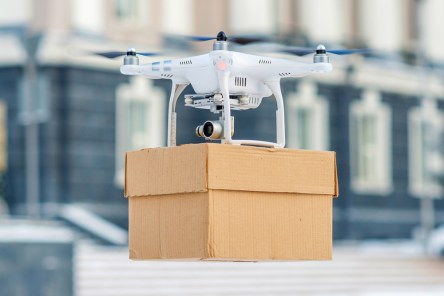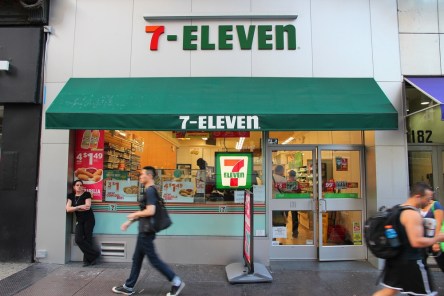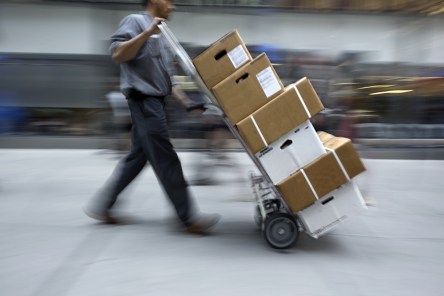From smart lockers to drone landing pads, multifamily prepares for the quickly evolving future o f e-commerce and deliveries. Alan Gershenhorn, chief commercial officer at UPS, reviewed the latest online sales data during a panel discussion with the National Multihousing Council: Brick-and-mortar retail has grown at approximately 2 percent each year. In comparison, e-commerce has grown in the teens. In 2015, online sales grew by 14.6 percent according to the U.S. Department of Commerce. Nearly half of UPS deliveries go to residences, continues Gershenhorn. As delivery quantities increase, multifamily leadership faces a series of challenges. Currently, delivered packages sit at the threshold of the residence where it is exposed to damage from the elements and at risk of theft. A missing package reflects poorly on the community and resident satisfaction scores. Within some multifamily communities, the package is delivered to the leasing office staff or concierge. This method poses an additional burden to staff members that are now accountable for the package. Staff must have adequate space to store the parcels, which can be anything from a tiny jewelry box to furniture and appliances. The staff must also find favorable conditions in which to store the packages. Food delivery and other perishable items require climate control. Multifamily leaders eagerly explore cost-effective solutions to their delivery and storage challenges. The ideal solution would offer security, flexible space, and perhaps even a degree of insulation. In terms of costs, having residents handle their own packages is a clear choice. The courier industry offers several self-serve options that limit the accountability of multifamily staff: UPS My Choice and FedEx Delivery Manager allow users to determine their delivery preferences, such as time and date. Users receive notifications of the package’s progress. UPS Access Point program relies on third-party...
Easy Package Pickups
New 7-Eleven Service
Some people hate shopping. Like myself. The idea of spending numerous hours walking in and out of countless stores, not finding the items I want, but buying some which I had no idea I needed, exhausts me mentally and physically. The day e-commerce became available, I felt relief. I no longer had to waste my time on never ending shopping trips, but could get what I needed without leaving the comfort of my couch. In the meantime, the industry has evolved. So have its shortcomings. One shortcoming is related to the wait: you place the order and then you wait. Or you stress out not knowing if you’ll be at home when the delivery guy shows up. Because you don’t like having your packages left on your doorstep. Perhaps you should have used your office address? What if your boss announces you that you have to travel on the exact day your package is due to arrive? To help solve this problem, Amazon and 7-Eleven have come up with the delivery locker system in 2011. The program proved to be highly successful, as recently 7-Eleven announced it made space for more lockers at a number of its North American stores where customers can pick up packages from FedEx, and United Parcel Service. In fact, any retailer that ships via UPS or FedEx has the locker as a delivery option. Moreover, the company said they will install Wal-Mart lockers in six locations in Toronto. The locker system is quite simple: anyone who shops online from a retailer who uses UPS or FedEx has the option of having their package sent directly to the nearest 7-Eleven for pick-up. When the package is delivered, the customer receives an email notification along with a bar code to his...
Special Delivery
Tech for Multifamily Mail
The holidays are coming… and with them comes a huge increase in resident packages! Are you ready? If that thought made you shudder a little bit, you’re not alone. Apartment communities and high-rise buildings see a dramatic influx of deliveries during the months of November and December. The question of how to deal with them in a way that will make both residents and staff happy is on every property manager’s mind right about now. First, we’ll take a look at some shipping stats so you can see exactly what communities just like yours are up against. Then we’ll identify challenges that every property faces. Finally, we’ll show you how simple technology solutions can help you handle shipments more efficiently. Because even Santa could use a hand during this time of year! The Stats Did you know that the typical apartment community can receive as many as 100 packages in a week—and that number can DOUBLE during the holidays? Last year, the National Multifamily Housing Council (NMHC) took a closer look at package delivery by the numbers. Take a look at their wonderful infographic below to see stats at a glance. We can only imagine that the numbers will be even bigger this year! The Challenges “When you receive 200 or 300 packages a week, it puts tremendous pressure on the staff to manage the influx of deliveries. And with 90 percent of retail sales still taking place in brick and mortar buildings, we’re only at the tip of the iceberg in terms of e-commerce,” said Rick Haughey, NMHC Vice President of Industry Technology Initiatives. The challenges that most community managers face regarding parcel deliveries really come down to three things: storage, manpower and resident notifications. Package storage: Where will you store packages after...
Special Delivery
Managing Packages
More than 37 million U.S. apartment residents receive enormous numbers of holiday packages every year. A load that large requires more than mere tracking numbers. For that reason, one in four apartment communities use specialized software to manage residents’ packages on site. These are among the findings from the National Multifamily Housing Council (NMHC) and Kingsley Associates’ 2014 Package Delivery Survey. The survey was fielded in October of this year, with 2,758 community managers from 28 leading firms responding. The survey also found that during the holiday season, a typical apartment community can receive double the typical 100 packages received weekly. After all, consumers spent $2.3 billion on Cyber Monday in 2013 alone. In more than three-quarters (77 percent) of apartment buildings surveyed, package carriers try to deliver to the door, as opposed to going to the manager’s office, but the number drops to one in five (20 percent) in high rises. If residents aren’t in, carriers take packages to the management office 70 percent of the time. This results in an enormous number of packages for the community manager to handle. “Managing deliveries is a real issue facing the industry,” says David Smith, chief operating officer and vice president, San Francisco-based Kingsley Associates. “There is inherent risk and valuable time associated with sorting, storing and notifying residents of package deliveries at the community level. Senior executives are clearly taking note of the escalating staff hours spent managing the process, particularly during the holidays.” Many apartment companies are increasingly adopting software solutions to help them get a handle on packages. Almost one-quarter, or 24 percent, of properties utilize software to track packages and notify residents. Among high-rise apartment communities, 60 percent are relying on specialized software. Apartment managers are as likely to notify residents...




